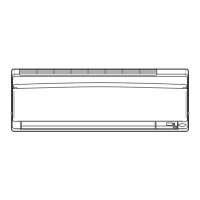Why my Daikin Air conditioning operation does not start soon?
- JjacobgonzalezAug 27, 2025
You should wait for about 3 minutes.

Why my Daikin Air conditioning operation does not start soon?
You should wait for about 3 minutes.
What to do if water leaks from the indoor unit of Daikin Air conditioning?
If water leaks from the indoor unit, turn the breaker OFF and call the service shop.
What to do if Daikin Air conditioning operation stops suddenly and the OPERATION lamp flashes?
If the Daikin air conditioning stops suddenly and the OPERATION lamp flashes, clean the air filters or remove any obstacles. Then, turn the breaker OFF, turn it ON again, and try operating the air conditioner with the remote controller.
| Cooling Capacity | 2.5 kW |
|---|---|
| Heating Capacity | 3.2 kW |
| Energy Efficiency Ratio (EER) | 3.21 |
| Seasonal Energy Efficiency Ratio (SEER) | 6.1 |
| Power Supply | 220-240 V, 50 Hz |
| Refrigerant | R32 |
| Weight (Indoor Unit) | 9 kg |
| Weight (Outdoor Unit) | 26 kg |
| Noise Level (Indoor Unit) | 19 dB |
Detailed technical specifications for various components and models of the air conditioner.
Diagrams illustrating connections on printed circuit boards for system diagnostics and repair.
Wiring diagrams for wall-mounted indoor units of the 20/25/35 class.
Wiring diagrams for wall-mounted indoor units of the 50/60/71 class.
Wiring diagrams for duct-connected indoor units.
Wiring diagrams for floor/ceiling suspended dual type indoor units.
Wiring diagrams for floor-standing indoor units.
Wiring diagrams for outdoor units.
Overview of the primary operational functions of the air conditioning system.
Explanation of the inverter's frequency control principle for compressor speed regulation.
Detailed specifications and logic for various control functions within the system.
How compressor frequency is determined and controlled based on various parameters.
Detailed explanation of the electronic expansion valve's control functions in various modes.
Information on detected malfunctions, including sensor and overload issues.
Explanation of forced modes like cooling, heating, and wiring checks for installation.
Procedure for checking and correcting wiring errors using the system's diagnostic function.
Essential safety precautions to be followed during installation, operation, and maintenance.
Guidelines for cleaning the indoor unit, outdoor unit, remote controller, and filters.
Common problems and their solutions, including checks for non-starting, stopping, and abnormal operations.
Important cautions and guidelines to follow before performing any diagnostic procedures.
How to interpret the operation lamp's status for troubleshooting and identifying faults.
Lists common problems with corresponding measures for diagnosis and resolution.
Explanation of how to use the service check function for system diagnostics.
List of error codes displayed on the remote controller and their corresponding problem descriptions.
Detailed error codes displayed on the remote controller and the faults they indicate.
Comprehensive guide to troubleshooting various system malfunctions.
Troubleshooting steps for issues related to indoor units.
Troubleshooting steps for issues related to outdoor units.
Troubleshooting signal transmission errors between indoor and outdoor units.
Diagnosing and addressing OL activation or compressor overload issues.
Troubleshooting compressor lock conditions.
Troubleshooting input over-current detection errors.
Troubleshooting output over-current detection errors.
Diagnosing and resolving issues related to insufficient refrigerant gas.
Step-by-step guide for removing outer panels and components from 80/90 class outdoor units.
Procedure for removing the compressor from the outdoor unit.
Step-by-step guide for removing components from 50-75 class outdoor units.











